Choosing the ideal canine companion for your family is a significant decision, especially when seeking a large dog that won’t leave a trail of fur across your home. While the notion of a completely “non-shedding” dog is a common misconception – all dogs shed some hair and dander – many large breeds produce significantly less, making them perfect for allergy sufferers and those who prefer a tidy living space. If you’re envisioning a substantial furry friend without the hassle of excessive shedding, this guide will help you discover the best big family dogs that don’t shed.
Understanding Dog Shedding and “Hypoallergenic” Breeds
Before delving into specific breeds, it’s crucial to understand what causes shedding and the concept of “hypoallergenic” dogs. Many people react to proteins found in a dog’s saliva, urine, and dander (tiny skin flakes), rather than the fur itself. This dander clings to the fur and becomes airborne, often triggering allergic reactions.
Therefore, even short-coated dogs can pose issues if they produce a lot of dander. “Hypoallergenic” dogs aren’t truly allergen-free; instead, these breeds generally shed less fur, thus spreading less dander. This reduced shedding is key for families looking for a large dog that is easier on allergies and home cleanliness. For more options, explore various dog breeds that don t shed a lot.
Top Big Family Dogs That Don’t Shed Much
Let’s explore some of the best large dog breeds known for their minimal shedding, making them excellent choices for families. Keep in mind that individual shedding levels can still vary, even within these breeds.
Standard Poodle
The Standard Poodle is celebrated for its remarkable intelligence and distinctive hypoallergenic coat. This breed possesses a single-layered coat, which sheds considerably less than the double-layered coats common in most large dog breeds. Their elegant appearance and keen minds make them highly trainable and wonderful family pets. Standard Poodles do require consistent regular grooming to prevent their dense, curly fur from matting, especially if opting for specific Poodle haircuts.
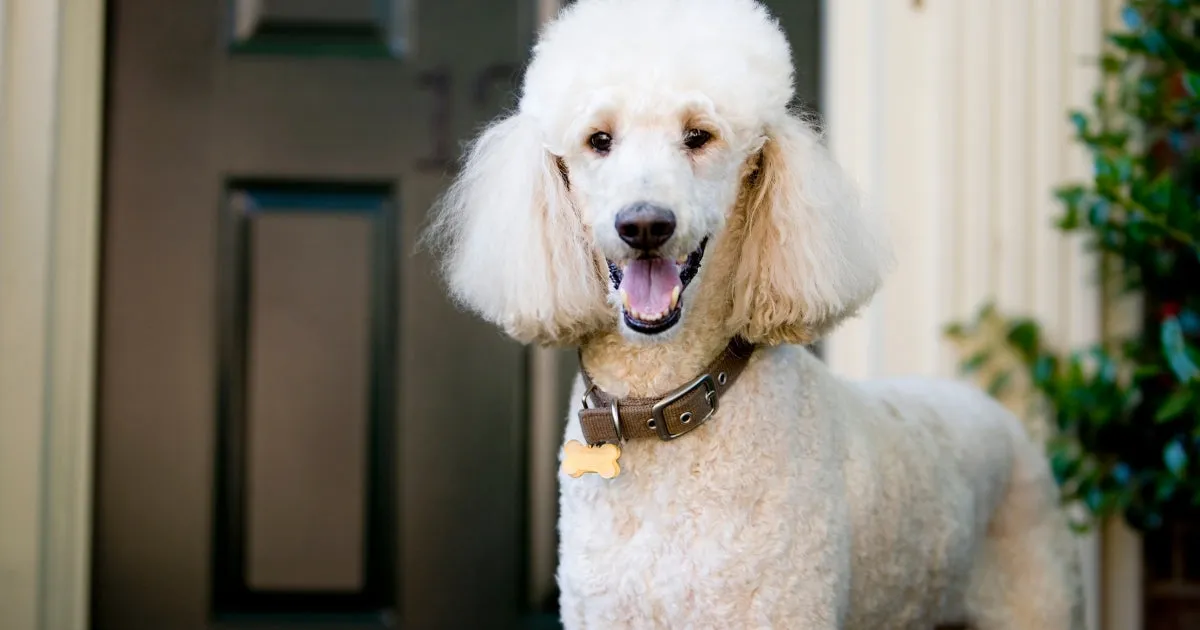 A white standard Poodle standing facing the camera looking happy.
A white standard Poodle standing facing the camera looking happy.
Giant Schnauzer
For families seeking a protective, calm, and highly trainable large dog, the Giant Schnauzer is an outstanding choice. These dogs exhibit minimal shedding compared to many other breeds. Their loyalty and impressive presence make them excellent guardians and devoted companions. To maintain their characteristic wiry coat, regular professional grooming is essential, which also helps to minimize dander around the house and keep their fur healthy.
Airedale Terrier
Affectionately known as the “King of Terriers,” the lively Airedale Terrier is the largest of all terrier breeds. Its short, wiry coat makes it a suitable option for pet owners who desire a large dog that doesn’t shed excessively. Airedales are known for their playful and energetic nature, making them great companions for active families who can provide plenty of exercise and mental stimulation. Regular stripping or hand-plucking of their coat helps maintain its texture and further reduces shedding.
Groodle
The Groodle, a charming and intelligent cross between a Golden Retriever and a Poodle, is renowned for its affectionate nature and adaptability. While their size can vary, many Groodles grow into large dogs, inheriting the Poodle’s hypoallergenic, low-shedding coat. Instead of shedding seasonally, their soft, wavy, or curly fur grows continuously, necessitating regular grooming to keep it clean, tangle-free, and in optimal condition. They are known for being gentle and good with children, fitting perfectly into family life.
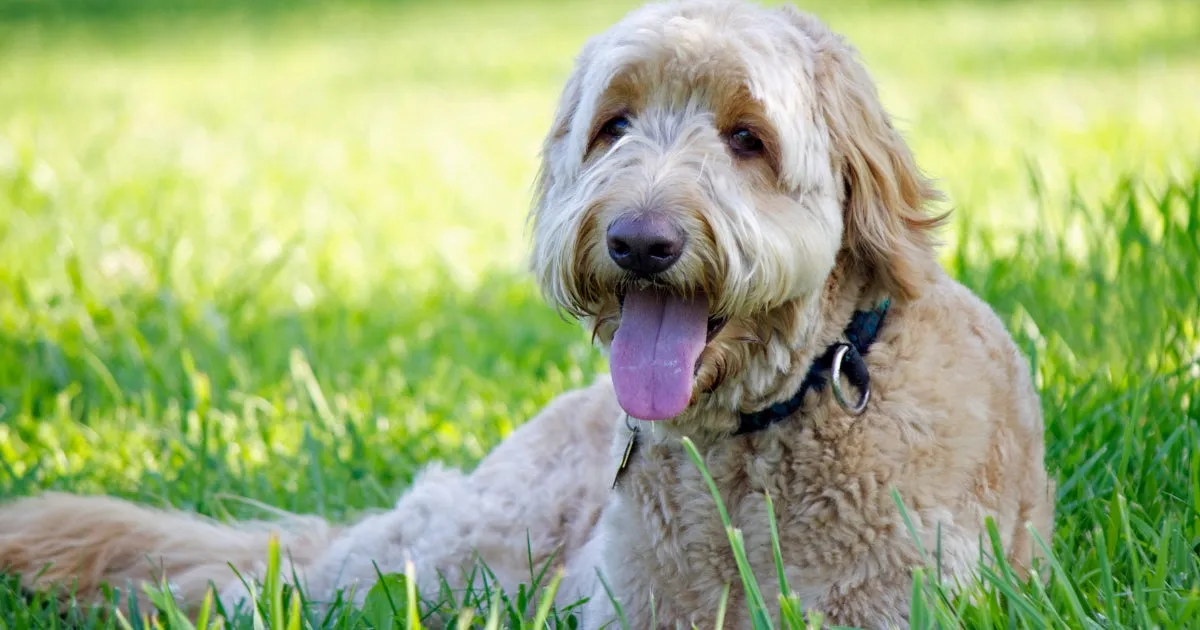 An apricot teddy bear looking Groodle laying in grass facing the camera with its tongue out.
An apricot teddy bear looking Groodle laying in grass facing the camera with its tongue out.
Afghan Hound
With its exceptionally long, flowing coat, the Afghan Hound might initially appear to be a high-shedding breed. However, it is surprisingly considered a low-shedding dog. This makes them a good choice for those concerned about dog hair on clothing and furniture. Afghan Hounds are known for their dignified and independent personalities, requiring a family that understands their unique temperament and is committed to maintaining their luxurious coat with diligent daily brushing.
Irish Water Spaniel
The Irish Water Spaniel is an energetic and intelligent breed characterized by its tightly curled, water-resistant coat that sheds minimally. As their name suggests, they have a natural love for water and require regular grooming to prevent their distinctive fur from matting. With their friendly and playful nature, Irish Water Spaniels make excellent companions for active families who enjoy outdoor activities and can provide them with ample exercise and engagement.
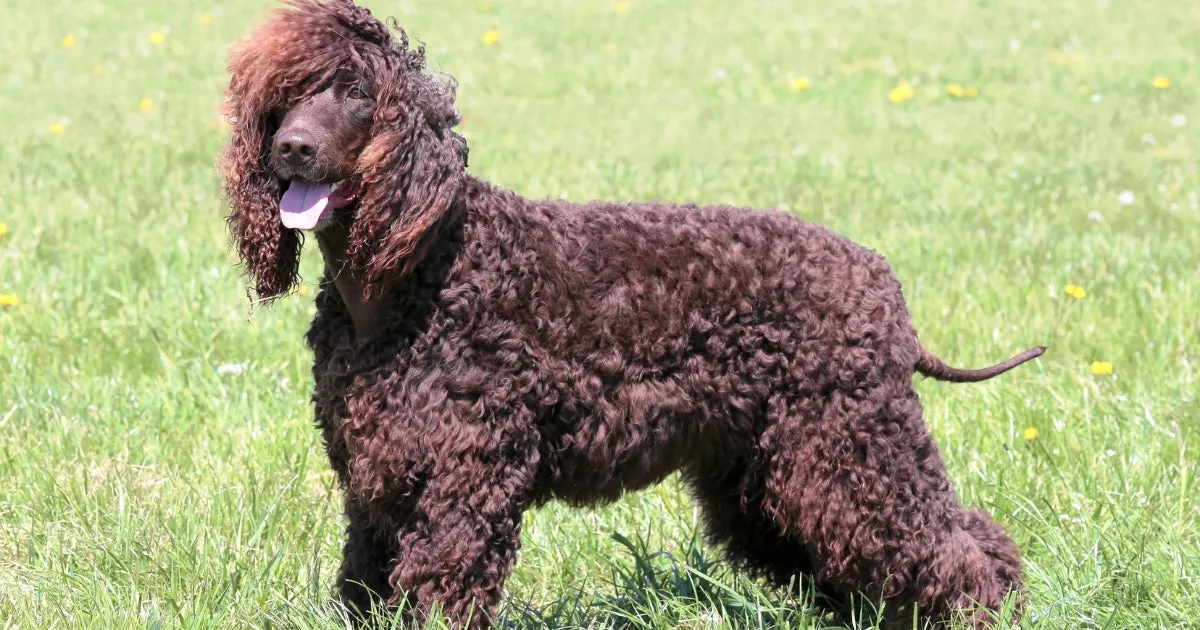 A brown Irish Water Spaniel with curly, dense fur.
A brown Irish Water Spaniel with curly, dense fur.
Lagotto Romagnolo
Originating from Italy, the Lagotto Romagnolo is an ancient water dog breed with a dense, curly, non-shedding coat. They were originally bred for waterfowl hunting and are famous for their truffle-hunting abilities. Known for their affectionate and loyal temperament, Lagotto Romagnolos make excellent family companions. They are energetic and highly intelligent, thriving on outdoor activities and mental challenges. Regular grooming is essential to maintain their unique coat and prevent matting.
Portuguese Water Dog
Portuguese Water Dogs are highly trainable, friendly, and thrive in active families capable of providing abundant exercise, mental stimulation, and opportunities to swim. Their distinctive coat is considered hypoallergenic and non-shedding, making them an ideal choice for households sensitive to allergies. Instead of shedding, their hair grows continuously, which means regular grooming is vital to prevent mats and tangles and keep their coat healthy and manageable.
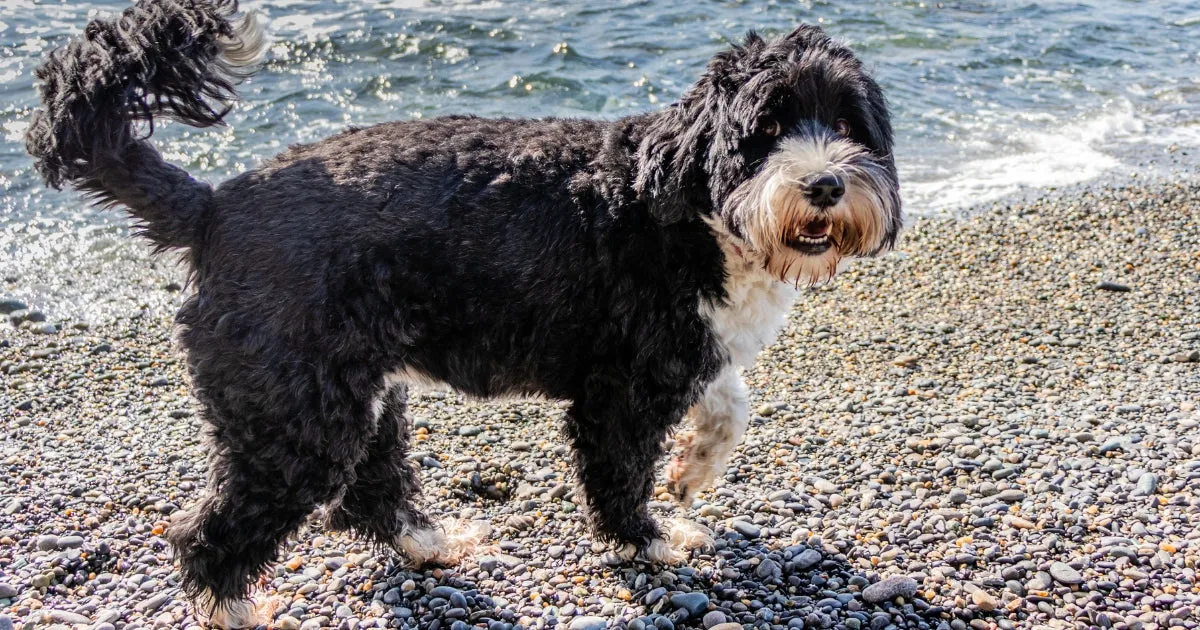 A black curly dog with a white chest and beard walking along the edge of the water.
A black curly dog with a white chest and beard walking along the edge of the water.
Komondor
The Komondor, also known as the Hungarian Sheepdog, is a large, powerful breed renowned for its distinctive, heavy, corded coat. This unique coat provides exceptional protection against harsh weather and predators. While virtually non-shedding, the Komondor’s unique cords demand significant grooming attention to maintain their texture and prevent severe matting. This big dog is naturally protective and loyal, making them an excellent guardian for livestock or a devoted family companion with proper training and early socialization.
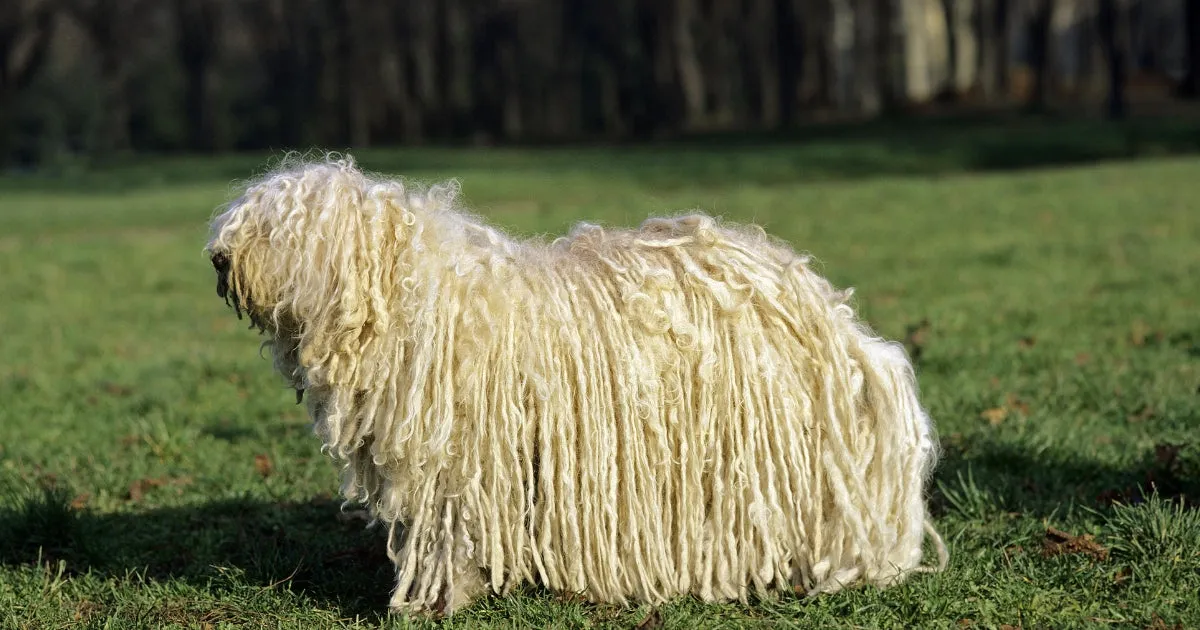 A Komondor dog with a distinctive white, corded coat.
A Komondor dog with a distinctive white, corded coat.
Peruvian Inca Orchid
The Peruvian Inca Orchid is a rare and elegant dog breed that is generally low-shedding. They come in both coated and hairless varieties. The short, smooth coats of the coated variety require minimal grooming. However, like other hairless breeds, their skin needs protection from harsh weather, particularly the hairless variety, which is sensitive to sunburn and cold temperatures. This affectionate and agile breed flourishes in active homes that can provide attentive care and understand their unique needs.
Wirehaired Pointing Griffon
Wirehaired Pointing Griffons are known to shed less than many other double-coated breeds. Their thick, wiry coat requires regular professional grooming to prevent mats and maintain its texture. While they may need daily brushing, they do not shed as profusely as some other dog breeds. These dogs are intelligent, eager to please, and make excellent companions for active families, especially those who enjoy outdoor adventures like hunting or hiking.
Grooming Tips for Low-Shedding Large Dogs
Even dogs classified as low-shedding require consistent grooming to keep their coats healthy and manage dander. Regular brushing is crucial as it helps remove any loose hair and dander that naturally accumulates, and it also aids in distributing natural skin oils, promoting a healthier coat. For non-shedding coats, frequent brushing is particularly important to prevent matting and tangling, which can become uncomfortable for your dog and lead to skin issues. Periodic professional trims are also necessary to keep their fur at a manageable length and maintain its style.
Using gentle shampoos designed for dogs, especially those formulated for sensitive skin, can cleanse the coat without causing irritation. Following up with conditioning treatments helps to keep their fur silky, soft, and less prone to tangles. Products specifically designed for paw and snout care, such as balms for cracked paws or dry noses, can also play a vital role in their overall grooming routine, ensuring your dog is not only clean but also comfortable. For additional options, you can also consider top dog breeds that don t shed.
Wiping your dog with a damp cloth or specially formulated dog wipes after walks or outdoor play can effectively remove lingering allergens and dirt. This simple practice helps significantly in reducing the amount of fur and dander spread throughout your home. Establishing a consistent grooming routine with the right tools and products tailored to your low-shedding large dog’s specific coat type will ensure your beloved furry friend looks and feels their absolute best, contributing to a cleaner home environment and a stronger bond between you.
FAQs about Big Family Dogs That Don’t Shed
Choosing a large, low-shedding dog often brings up several common questions for prospective owners. Here are some answers to help clarify your decision.
What is the least shedding large dog?
While all dogs shed to some extent, certain large breeds are known for their minimal shedding. Breeds like the Standard Poodle, Giant Schnauzer, and Komondor are among the top contenders for the least shedding large dogs. Additionally, many “oodle” crossbreeds, such as Labradoodles and Goldendoodles, are also popular choices due to their Poodle heritage, which often results in a hypoallergenic, curly coat that sheds very little.
What is the largest breed of non-shedding dog?
The Standard Poodle is generally considered the largest non-shedding dog breed. While other large breeds like the Giant Schnauzer or Komondor also exhibit minimal shedding, the Standard Poodle stands out due to its impressive size, combined with its distinct hypoallergenic and low-shedding coat. Standard Poodles typically weigh between 40 to 70 pounds (18 to 32 kilograms) and boast a dense, curly coat that grows continuously and requires regular grooming to maintain its health and appearance.
What is the calmest large dog?
Temperament can vary significantly between individual dogs and within breeds, so there are no absolute guarantees. However, many larger non-shedding breeds are often noted for their gentle and more laid-back nature, potentially requiring less intense exercise compared to some other large breeds. Examples include the Standard Poodle, Irish Water Spaniel, and Bergamasco Sheepdog, which are often cited for their calm demeanor. These breeds can make excellent companions for families seeking a relaxed dog with minimal shedding, provided they receive appropriate training and socialization.
Which dog sheds the least in Australia?
The same low-shedding breeds popular globally, such as Poodles and Schnauzers, are also highly suitable for homes in Australia. With regular grooming, these breeds can significantly reduce allergy triggers. Other breeds known for their minimal shedding that are found in Australia include the Kerry Blue Terrier, Lagotto Romagnolo, Wirehaired Pointing Griffon, and Groodle. These breeds are excellent choices for Australian families looking for a large dog with a low-maintenance coat.
Conclusion
Selecting a furry family member is a significant commitment, especially when your heart is set on big family dogs that don’t shed. While no dog is truly “non-shedding,” a variety of magnificent large breeds offer minimal shedding, making them wonderful, lifelong companions for various households. These low-shedding options can be a fantastic way to enjoy the profound love and loyalty of a large dog without the constant concern of excessive hair around your home.
Breeds like the Standard Poodle, Groodle, or Portuguese Water Dog are excellent choices, particularly for families with allergy sufferers, as they produce very little dog hair and dander. Finding the right large, low-shedding dog breed tailored to your family’s lifestyle means you can enjoy a clean, cozy home while building an incredible and lasting bond with your new furry companion. Explore these breeds further and consult with a reputable breeder or veterinarian to find the perfect fit for your home.
